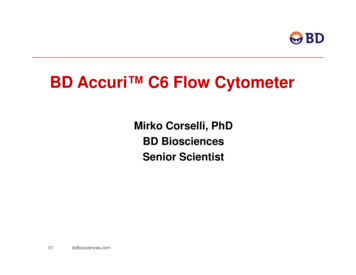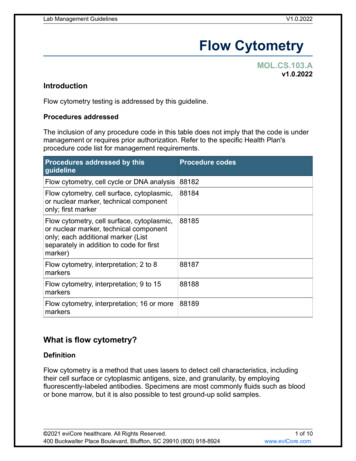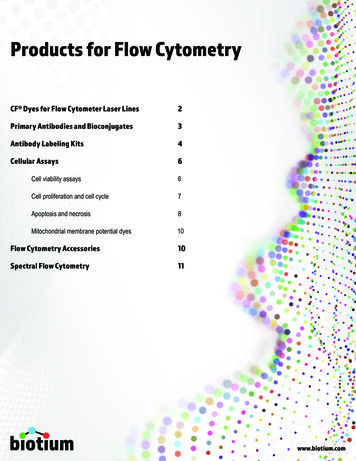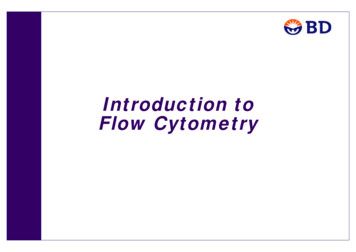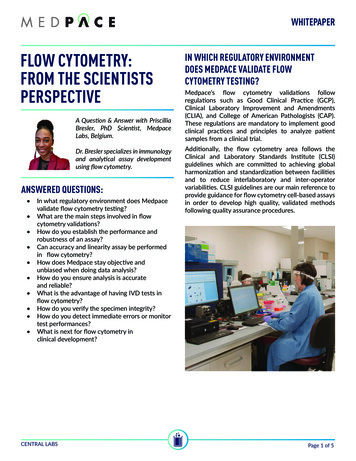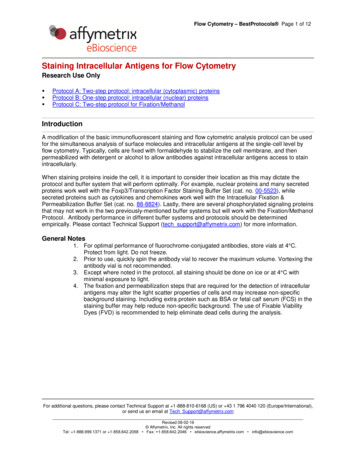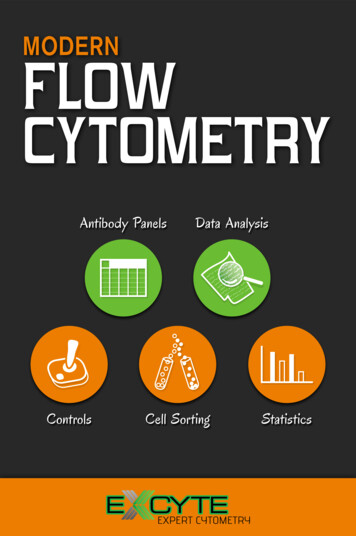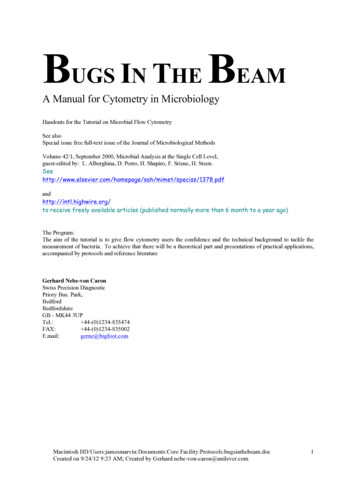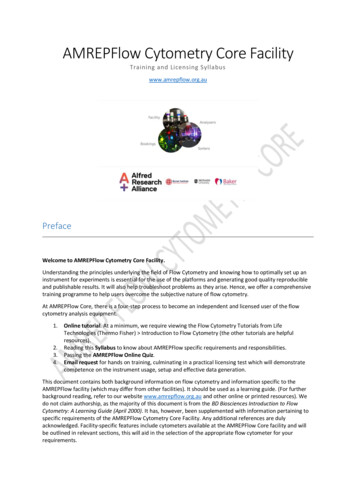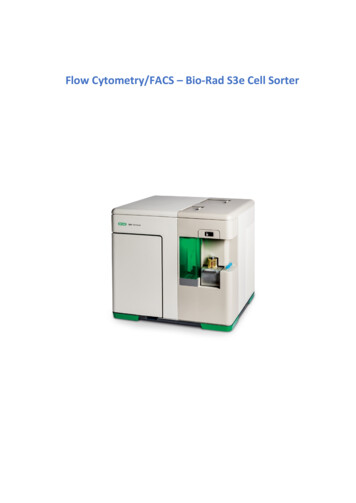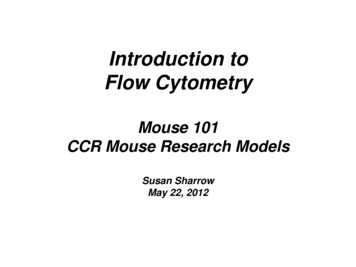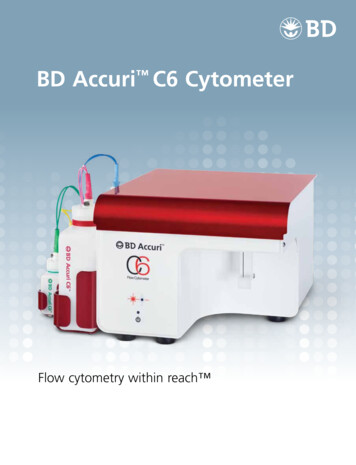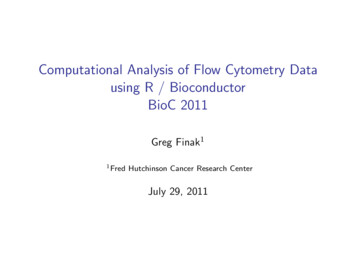
Transcription
Computational Analysis of Flow Cytometry Datausing R / BioconductorBioC 2011Greg Finak11 FredHutchinson Cancer Research CenterJuly 29, 2011
IntroductionThe purpose of this workshop is to demonstrate advances in thedevelopment of R packages that support the gating and analysis ofcomplex flow cytometry datasets.Current Software Development Status1. flowCore and related packages are stable, robust, and highlyfunctional.2. There is a new package flowWorkspace for communicatingbetween R and FlowJo.These capabilities now make it feasible to analyze complex flowdatasets and directly compare the results to results obtained fromFlowJo.In this workshop, we’ll demonstrate the use of these new tools.The data and code are available at the Bioconductor website.
The Importance of the R/FlowJo DialogR and FlowJo provide two different, equally important roles dataanalysis.Benefits of Collaboration1. FlowJo enables the cytometrist to develop an analysis thatcaptures biological meaning.2. R enables the use of modern machine learning methods andobjective, numerical approaches.3. The informatician needs to understand what the cytometristdid to ensure the correct methods are used.4. The cytometrist needs to review and validate the results ofthe R analysis.The new possibilities for collaboration will increase theeffectiveness of both approaches.
A 96-Well Plate Flow AssayWe will do a comparative analysis of a flow cytometry assay doneon a 96-well plate.Two Ways to Use flowCore1. Import a flowJo workspace with gates, transforms, andcompensation matrices2. Analyze from scratch within BioConductorThe aim of the assay is to identify wells with cells that are positivefor pairwise combinations of three markers.We’ll walk through each analysis then compare the results.
Setting up the R sessionFirst we set up the environment by telling R where to find FCSfiles and where to execute code.Setup #Set the path to the FCS files in the packagefcspath -system.file("extdata",package "BioC2011FlowWorkshop")#load ncdf4 -require(ncdf4)
RequirementsSoftware:IDevelopment version of R (2.14) and Bioconductor (2.9)IflowWorkspace (0.99.14) and flowWorkspaceData(0.99.4)Download uctor.org/packages/2.9/html/flowWorkspace.html
Installation from BioconductorEnsure Packages are up to date update.packages();Install flowWorkspace and flowWorkspaceData from Bioconductorrepository source("http://www.bioconductor.org/biocLite.R") dencies TRUE);
Opening and Importing flowJo WorkspacesParsing a flowJo Workspace xmlfile - system.file("extdata", package "BasicFlowWorkshop",mustWork TRUE)xmlfile - list.files(pattern "BDWorkspace.xml",xmlfile, full T)ws - openWorkspace(xmlfile)G - try(parseWorkspace(ws, execute TRUE, isNcdf FALSE,path fcspath, name "samples"))openWorkspace() will open an XML flowJo workspace file. Youcan get more information about it with: show(ws)parseWorkspace() will parse the flowJo workspace fileAdditionally we tell it to execute the compensation,transformation,and gating, don’t use netCDF, where are the FCS files, and thename of the group of samples to import.
GatingSet and GatingHierarchy G[1:2]A GatingSet with 2 samples1 . FCS File: Specimen 001 B2 B02.fcsGatingHierarchy with 3 gates2 . FCS File: Specimen 001 B1 B01.fcsGatingHierarchy with 3 gates plot(G[[1]])Specimen 001 B2 B02.fcs10.liveDead11.normalMorphologyG is a GatingSet, which is a list of GatingHierarchy objects.Each describes a sample in the flowJo workspace and how it iscompensated, transformed,and gated.
Exploring the DataWe can plot individual gates for samples (GatingHierarchy) in aGatingSet.plotGate print(plotGate(G[[1]], getNodes(G[[1]])[3]))250000SSC A2000001500001000005000000 50000150000250000
Extracting Population StatisticsgetPopStats() require(xtable)getPopStats(G[[5]])stats - do.call(cbind, lapply(G, function(x) getPopStats(x)[,1]))rownames(stats) - rownames(getPopStats(G[[1]]))colnames(stats) - getSamples(G)print(xtable(t(stats)[1:10, ]), size C02.fcsSpecimen 001 B2 0.800.770.78
Some Quality Control after Importing a WorkspaceplotPopCV #Plot the coefficient of variation for the first #9 samples (to save space) print(plotPopCV(G[1:9],rot 45));Specimen 001 B7 B07.fcsSpecimen 001 B8 B08.fcsSpecimen 001 C1 C01.fcs0.0040.0020.000Specimen 001 B4 B04.fcsSpecimen 001 B5 B05.fcsSpecimen 001 B6 B06.fcscv0.0040.0020.000Specimen 001 B1 B01.fcsSpecimen 001 B2 B02.fcsSpecimen 001 B3 B03.fcsecSpSpecimen001B2im norB0en ma0 lM live 2.fc01 or D sSpB ph eaec n2 olo dim orB0 gyen ma0 lM live 2.fc01 or D sB ph ea2 olo dnoB gyrmal liv 02.M e fcor D sph eaol dogy0.0040.0020.000
Some HousekeepingSet Metadata FITC.WELL "B02"PE.WELL "B03"APC.WELL "B04"pData(G) - data.frame(WELL unlist(lapply(G,function(x) keyword(x, "WELL ID")[[1]])))ISpecify the FITC, PE, and APC isotype control wells.IEnsure metadata for the GatingSet is up to date.IExtract the ‘WELL ID‘ keyword from each sample.
Calculate Cutoffs from Isotype ControlsWe’ve imported gates, transformations and compensation matrices.We can just extract the data from the GatingHierarchy at position3.Extracting Gated Data mydata - getData(G[[which(pData(G) FITC.WELL)]],3)fitc.cutoff - quantile(exprs(mydata[, " FITC-A "]),0.99)mydata - getData(G[[which(pData(G) PE.WELL)]],3)pe.cutoff - quantile(exprs(mydata[, " PE-A "]),0.99)mydata - getData(G[[which(pData(G) APC.WELL)]],3)apc.cutoff - quantile(exprs(mydata[, " APC-A "]),0.99)Then compute the 99% cutoff for each isotype controlchannel/well.
Get Non–Control Wells d - getData(G[which(pData(G) ! FITC.WELL & pData(G) ! PE.WELL & pData(G) ! APC.WELL)], 3)[, c(" FITC-A ", " PE-A ", " APC-A ")]Adjust Metadata phenodata - pData(G[which(pData(G) ! FITC.WELL & pData(G) ! PE.WELL & pData(G) ! APC.WELL)]) sampleNames(d) - rownames(phenodata) pData(d) - data.frame(phenodata, Name rownames(pData(d)))Compute Positive Cell Counts tables - unlist(fsApply(d, function(x) { df - data.frame(t(t(exprs(x)) c(fitc.cutoff, pe.cutoff, apc.cutoff))) for (i in 1:ncol(df)) { df[, i] - factor(df[, i], levels c("FALSE", "TRUE")) } colnames(df) - c("FITC", "PE", "APC") tbl - table(df) list(tbl) }), recursive F)
Cross-Tabulation print(tables[[10]]), , APC FALSEPEFITCFALSE TRUEFALSE236 244TRUE2730, , APC TRUEPEFITCFALSE TRUEFALSE252 835TRUE36 151
Calculate Proportions from CountsOrganize the Results #Calculate % positive cells for each combination of FITC/PE/APCres (x/sum(x)))))#Define groups by well and by FITC/PE/APC combores -data.frame(proportion as.vector(res),combo gl(8,81),well factor(as.numeric(as.vector(t(matrix(gl(81,8),nrow 8))))))#Relabel the combos to through --res[,2] -factor(c("---"," --","- -"," -","-- "," - ","- "," "))[res[,2]]Calculate proportions as fraction of the total cells (after gating).Add variables identifying:Icommon measurements from each wellIcommon combinations across wells.
Tabulated data print(res[sample(1:648, 15), ortion combo well0.3281165677-- 400.0005583473 -330.0817166373- 560.0000000000 560.0235798499 240.0000000000 120.0076880835 -170.9828729282 500.0060273973 190.0647284696-- 580.0000000000 - 10.0005420054 -540.5214592275-- 690.1708378672 -670.0083989501- 62
Plotting Results print(barchart(proportion combo well, data res, scales list(x list(rot 90)), subset as.numeric(res[, 2]) %in% c(2, 3, 5), main "Double-Positive Events by Well - flowWorkDouble Positive Events by Well 212223242526271011121314151617181234567890.80.40.0 80.40.0
That Was Easy.Because we imported the workspace from flowJo we had little todo in the way of gating or other data pre-processing.Now let’s repeat the analysis but do the compensation and gatingin flowCore.
Reading in a flowSetread.flowSet dat - read.flowSet(files list.files(fcspath, pattern "fcs", full T))read.flowSet will load in a collection of FCS files that share acommon set of parameters.Isimilar to a GatingSetIno gating, compensation, or transformation information
HousekeepingUpdate Metadata, etc. pData(dat) - data.frame(pData(dat)[, 1], well keyword(dat,"WELL ID"))varMetadata(phenoData(dat)) labelDescription - c("Name","Well")compWells c("A08", "A09", "A10", "A11", "A12")ldWell "A09"ldChan "APC-Cy7-A"unstainedWell 1namePattern "FITC-A PE-A APC-A APC-Cy7-A FSC-A SSC-A"ISame as before, update the phenoData with WELL IDinformation.IIdentify the compensation control wells
Calculate the Spillover MatrixSpillover comps - dat[which(pData(dat) WELL.ID %in% compWells)] spill - spillover(x comps, unstained unstainedWell, patt namePattern, fsc "FSC-A", ssc "SSC-A", useNormFilt TRUE)flowCore has a handy method, spillover, that can automaticallycompute the spillover matrix for you.Icomps is a flowSet of compensation wellsIunstained identifies which well is the unstained controlIpatt is a regular expression to select the desired columns(defined on previous slide)Ifsc and ssc - obviousIuseNormFilt - use autogating to select a homogeneouspopulation
Compensationusing workFlow() dat - dat[which(!pData(dat) WELL.ID %in% compWells)] wf - workFlow(dat) add(wf, compensation(spill, compensationId "Plate Defined"))Workflows help organize an analysis in a coherent way.IIworkFlow() will create a workflow object and initialize it withsome raw data.add() will add actions to a workflow.Icompensation, transformation, gating.NoteworkFlows apply the same action to all samples in a flowSetGatingSet and GatingHierarchy allow different actions for eachsample.
TransformationLogicle / Biexponential Transformation tr - estimateLogicle(flowFrame(fsApply(dat, function(x) exprs(x))), colnames(dat)[4:7]) identifier(tr) - "commonLogicle" add(wf, tr, parent "Plate Defined")Icombine all wellsIestimate the parameters of the logicle from the dataIadd to the workflow (apply the transformation)Iparent specifies what data to apply the action.
Gating Live / Dead CellsrangeGate() Example rg - rangeGate(Data(wf[["commonLogicle"]])[[1]], stain ldChan, filterId "liveDeadGate", refLine 1, plot T)breakpoint for parameter APC Cy7 A0.00.5Density1.01.5breakpointdens region123N 2403 Bandwidth 0.047844AutogatingIrangeGate identifies thesplit between populationsIGating live (-ive staining) vsdead ( ive stating) cells
Gating Live / Dead CellsGate the workFlow rg - rangeGate(Data(wf[["commonLogicle"]]), stain ldChan, filterId "liveDeadGate", refLine 1) add(wf, rg, parent "commonLogicle")IDefine a rangeGate on the flowSetIAdd it to the workflow (parent "commonLogicle")
Filter Boundary EventsboundaryFilter bnd - boundaryFilter(c("FSC-A", "SSC-A"), filterId "boundary", tolerance c(10, 10)) add(wf, bnd, parent "liveDeadGate-")250000200000150000SSC A050000100000150000100000500000SSC A200000250000Filter boundary (saturated or off–scale) events from the FSC andSSC channels.With boundary events.Without boundary events050000100000150000FSC A200000250000050000100000150000FSC A200000250000
Normal Morphology Gatecurv2Filter() example print(xyplot( SSC-A FSC-A , Data(wf[["boundary "]])[1:4], filter filter(Data(wf[["boundary "]])[1:4], curv2Filter("FSC-A", "SSC-A", filterId "normalMorphology", bwFac 7, gridsize c(151, 151)))))0 50000150000250000Specimen 001 B1 B01.fcs Specimen 001 B2 B02.fcs250000200000150000100000SSC A500000Specimen 001 B3 B03.fcs Specimen 001 B4 B04.fcs2500002000001500001000005000000 50000150000250000FSC A
Normal Morphology GateGate Remaining Samples nmorph - curv2Filter("FSC-A", "SSC-A", bwFac 7, gridsize c(151, 151), filterId "normalMorphology") add(wf, nmorph, parent "boundary ")Extract Isotype Cutoff Values fitc.cutoff.wf -quantile(exprs(Data(wf[["area 1"]])[which( pData(Data(wf[["area 1"]])) WELL.ID%in%FITC.WELL)][[1]][,"FITC-A"]), 0.99) pe.cutoff.wf -quantile(exprs(Data(wf[["area 1"]])[which( pData(Data(wf[["area 1"]])) WELL.ID%in%PE.WELL)][[1]][,"PE-A"]), 0.99) apc.cutoff.wf -quantile(exprs(Data(wf[["area 1"]])[which( pData(Data(wf[["area 1"]])) WELL.ID%in%APC.WELL)][[1]][,"APC-A"]), 0.99)
HousekeepingGet the non-control wells dat - Data(wf[["area 1"]])[!pData(Data(wf[["area 1"]])) WELL.ID %in% c(FITC.WELL, APC.WELL, PE.WELL)][, c("FITC-A", "PE-A", "APC-A")]Reorder samples dat - dat[match(as.character(pData(d)[, 1]), as.character(pData(dat)[, 2]))]For later comparison we reorder the samples so that they are in thesame order as in the flowJoWorkspace.
Finally.Organize the results #for each sample count the events that are#above the isotype control cutoffstables.wf -fsApply(dat,function(x){r -t(t(exprs(x)) c(fitc.cutoff.wf,pe.cutoff.wf,apc.cutoff.wf));#put them in a data framer -data.frame(r);#Label them nicelyfor(i in 1:ncol(r)){r[,i] -factor(r[,i],levels c("FALSE","TRUE"))};#tabulate countscolnames(r) .wf -unlist(tables.wf,recursive F)#compute proportions from countsres.wf or(x/sum(x))))#make a nice final data frameres.wf -data.frame(proportion as.vector(res.wf),combo gl(8,81),well factor(as.numeric(as.vector(t(matrix(gl(81,8),nrow 8))))))res.wf[,2] -factor(c("---"," --","- -"," -","-- "," - ","- "," "))[res.wf[,2]]
Data frame of output print(res.wf[sample(1:dim(res.wf)[1], 15), rtion combo well0.0000000000 - 80.0004909180 490.0004780115 - 160.0000000000 - 760.0163540164--180.0000000000- 150.1622659626- 450.0110630111 -180.0000000000- 510.0186732187 - 430.0235237638 350.0000000000-- 780.0024666996 340.3675213675 510.0004880429 -54
Plot the resultsbarchart. print(barchart(proportion combo well, data res.wf, scales list(x list(rot 90)), subset as.numeric(res.wf[, 2]) %in% c(2, 3, 5), main "Double-Positive Events by Well - Bioconductor"))Double Positive Events by Well 12223242526271011121314151617181234567890.80.40.0 80.40.0The two analyses look prettysimilar! We should take a closerlook.
Comparison Across Analyses res3 - data.frame(rbind(res, res.wf), analysis gl(2, dim(res)[1], labels c("flowJo", "flowCore"))) print(barchart(proportion combo well, ylim c(-0.1, 1.1), data res3, subset which(as.numeric(res3[, 2]) %in% c(2, 3, 5)), group analysis, main "Positive Wells Across Analyses", auto.key TRUE))
Positive Wells Across 1314151617181234567890.80.40.0 0.80.40.00.80.40.00.80.40.00.80.40.0
Comparison Across AnalysesConcordant Wells cv - 0.01 high - 0.25 print(barchart(proportion combo well, ylim c(-0.1, 1.1), data res3, subset which(apply(cbind(res[, 1], res.wf[, 1]), 1, function(x) sd(x)/mean(x)) cv & as.numeric(res3[, 2]) %in% c(2, 3, 5) & (res[, 1] high res.wf[, 1] high)), group analysis, main "Concordant Wells Across Analyses", auto.key TRUE))Pick out wells with C.V. 1% and proportion 25%
Concordant Wells Across .80.60.40.20.04579181.00.80.60.40.20.0
In ConclusionYou should now have a basis (examples and working code) foranalyzing your own data.-Import preprocessing and gates from flowJo-Or (for the brave) entirely within BioConductorOther features of flowWorkspace not covered here:-NetCDF support (requires ncdf4 package and netcdf4 C library)Just pass isNCDF TRUE to parseWorkspace()-Parallel processing using Rmpi and multicore packages.Pass nslaves # to parseWorkspace()More complete netCDF support coming (ncdfFlow package).flowWorkspace constantly being improved.
Acknowledgementsrglab.orgBioconductorIRaphael GottardoIMike JiangINishant GopalakrishnanIMose AndreIChao-Jen WongHVTNISteve DeRosaFunding NIH R01 EB008400 andthe ITN
A 96-Well Plate Flow Assay We will do a comparative analysis of a ow cytometry assay done on a 96-well plate. Two Ways to Use owCore 1.Import a owJo workspace with gates, transforms, and compensation matrices 2.Analyze from scratch within BioConductor The aim of the assay is to identify wells with cells that are positive
